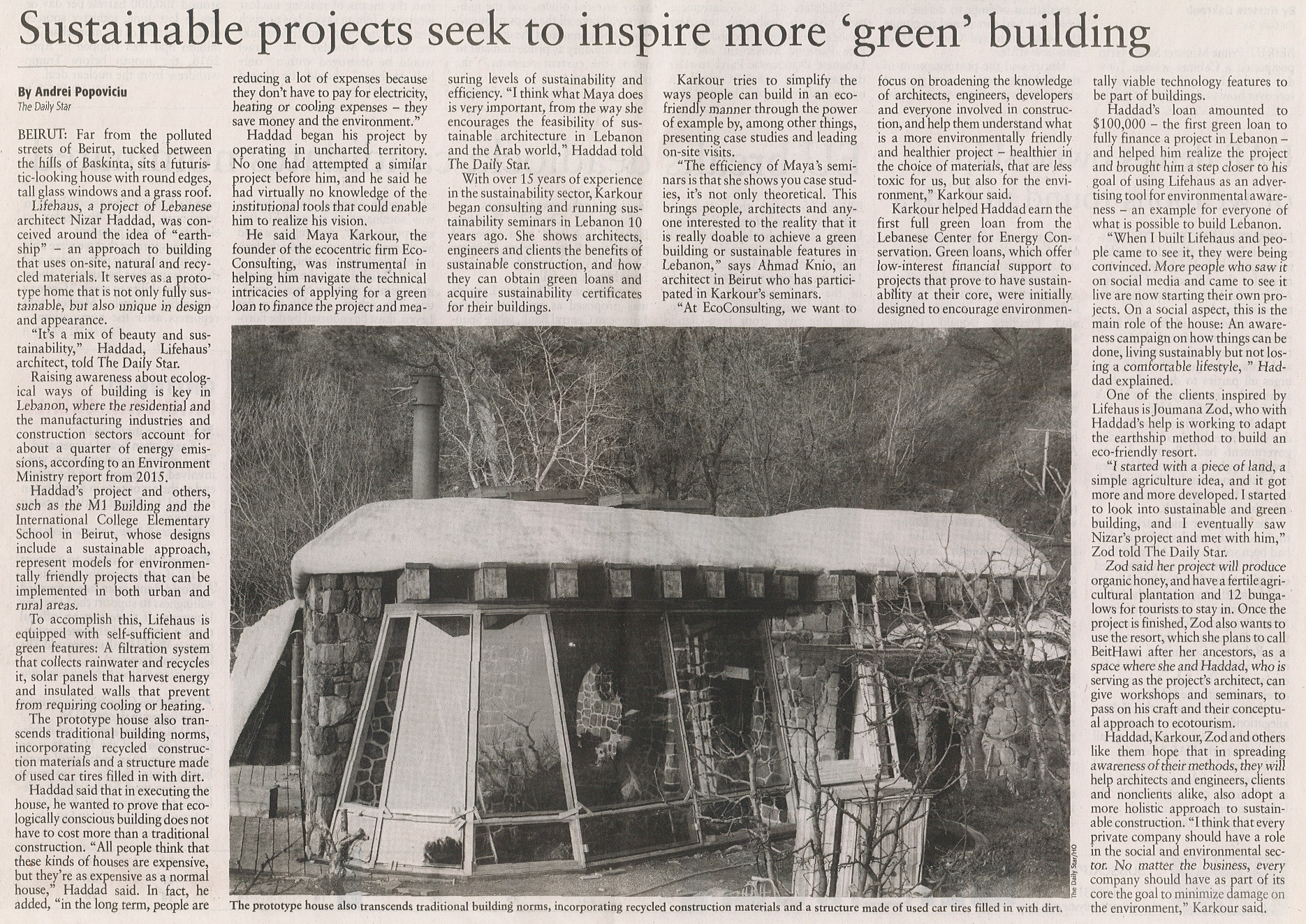Sustainable projects seek to inspire more ‘green’ building
A version of this article appeared in the web edition of The Daily Star on July 03, 2019.

BEIRUT: Far from the polluted streets of Beirut, tucked between the hills of Baskinta, sits a futuristic-looking house with round edges, tall glass windows and a grass roof. Lifehaus, a project of Lebanese architect Nizar Haddad, was conceived around the idea of “earthship” - an approach to building that uses on-site, natural and recycled materials. It serves as a prototype home that is not only fully sustainable, but also unique in design and appearance.
“It’s a mix of beauty and sustainability,” Haddad, Lifehaus’ architect, told The Daily Star.
Raising awareness about ecological ways of building is key in Lebanon, where the residential and the manufacturing industries and construction sectors account for about a quarter of energy emissions, according to an Environment Ministry report from 2015.
Haddad’s project and others, such as the M1 Building and the International College Elementary School in Beirut, whose designs include a sustainable approach, represent models for environmentally friendly projects that can be implemented in both urban and rural areas.
To accomplish this, Lifehaus is equipped with self-sufficient and green features: A filtration system that collects rainwater and recycles it, solar panels that harvest energy and insulated walls that prevent from requiring cooling or heating.
The prototype house also transcends traditional building norms, incorporating recycled construction materials and a structure made of used car tires filled in with dirt.
Haddad said that in executing the house, he wanted to prove that ecologically conscious building does not have to cost more than a traditional construction. “All people think that these kinds of houses are expensive, but they’re as expensive as a normal house,” Haddad said. In fact, he added, “in the long term, people are reducing a lot of expenses because they don’t have to pay for electricity, heating or cooling expenses - they save money and the environment.”
Haddad began his project by operating in uncharted territory. No one had attempted a similar project before him, and he said he had virtually no knowledge of the institutional tools that could enable him to realize his vision.
He said Maya Karkour, the founder of the ecocentric firm EcoConsulting, was instrumental in helping him navigate the technical intricacies of applying for a green loan to finance the project and measuring levels of sustainability and efficiency. “I think what Maya does is very important, from the way she encourages the feasibility of sustainable architecture in Lebanon and the Arab world,” Haddad told The Daily Star.
With over 15 years of experience in the sustainability sector, Karkour began consulting and running sustainability seminars in Lebanon 10 years ago. She shows architects, engineers and clients the benefits of sustainable construction, and how they can obtain green loans and acquire sustainability certificates for their buildings.
Karkour tries to simplify the ways people can build in an eco-friendly manner through the power of example by, among other things, presenting case studies and leading on-site visits.
“The efficiency of Maya’s seminars is that she shows you case studies, it’s not only theoretical. This brings people, architects and anyone interested to the reality that it is really doable to achieve a green building or sustainable features in Lebanon,” says Ahmad Knio, an architect in Beirut who has participated in Karkour’s seminars.
“At EcoConsulting, we want to focus on broadening the knowledge of architects, engineers, developers and everyone involved in construction, and help them understand what is a more environmentally friendly and healthier project - healthier in the choice of materials, that are less toxic for us, but also for the environment,” Karkour said.
Karkour helped Haddad earn the first full green loan from the Lebanese Center for Energy Conservation. Green loans, which offer low-interest financial support to projects that prove to have sustainability at their core, were initially designed to encourage environmentally viable technology features to be part of buildings.
Haddad’s loan amounted to $100,000 - the first green loan to fully finance a project in Lebanon - and helped him realize the project and brought him a step closer to his goal of using Lifehaus as an advertising tool for environmental awareness - an example for everyone of what is possible to build Lebanon.
“When I built Lifehaus and people came to see it, they were being convinced. More people who saw it on social media and came to see it live are now starting their own projects. On a social aspect, this is the main role of the house: An awareness campaign on how things can be done, living sustainably but not losing a comfortable lifestyle, ” Haddad explained.
One of the clients inspired by Lifehaus is Joumana Zod, who with Haddad’s help is working to adapt the earthship method to build an eco-friendly resort.
“I started with a piece of land, a simple agriculture idea, and it got more and more developed. I started to look into sustainable and green building, and I eventually saw Nizar’s project and met with him,” Zod told The Daily Star.
Zod said her project will produce organic honey, and have a fertile agricultural plantation and 12 bungalows for tourists to stay in. Once the project is finished, Zod also wants to use the resort, which she plans to call BeitHawi after her ancestors, as a space where she and Haddad, who is serving as the project’s architect, can give workshops and seminars, to pass on his craft and their conceptual approach to ecotourism.
Haddad, Karkour, Zod and others like them hope that in spreading awareness of their methods, they will help architects and engineers, clients and nonclients alike, also adopt a more holistic approach to sustainable construction. “I think that every private company should have a role in the social and environmental sector. No matter the business, every company should have as part of its core the goal to minimize damage on the environment,” Karkour said.
Post a comment